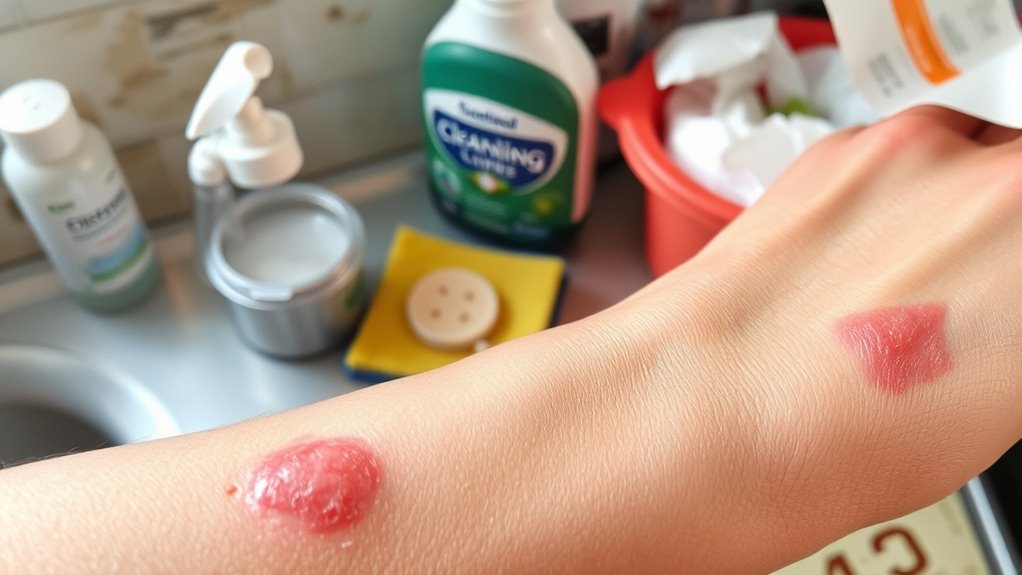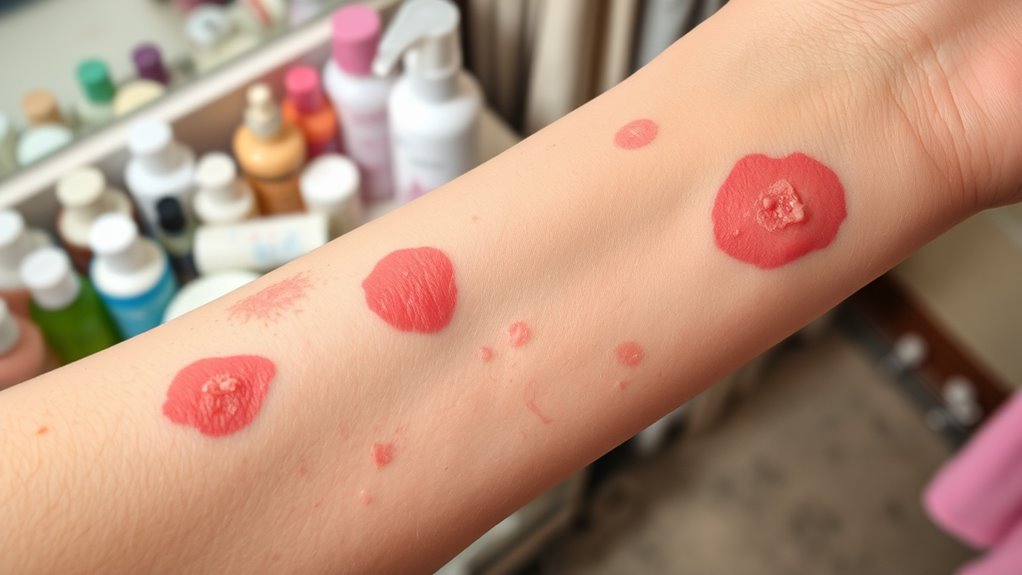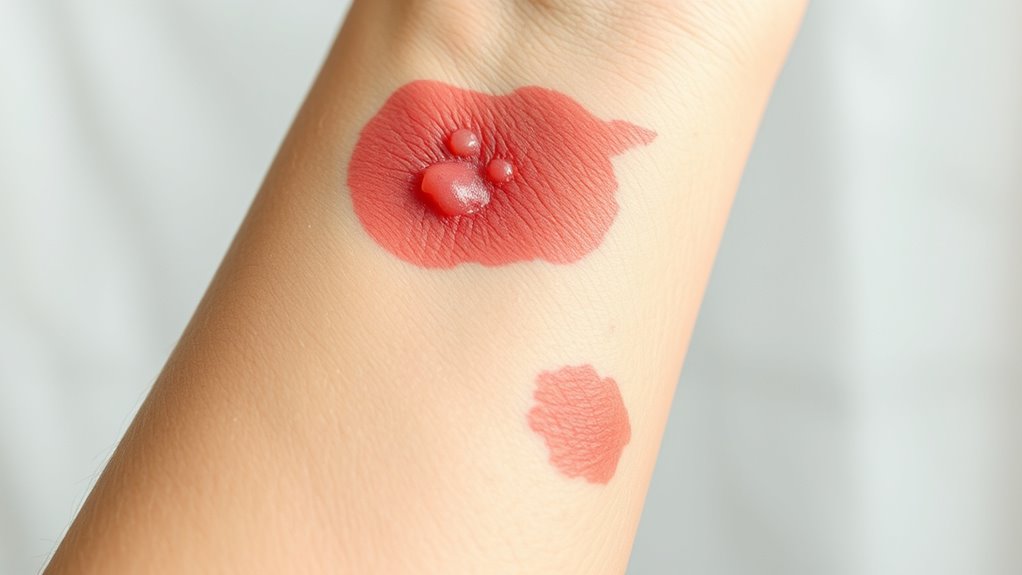To identify contact dermatitis allergens, examine common sources like household products, including soaps, detergents, and fragrances, which can irritate your skin. Consider workplace substances like solvents or metals such as nickel, and personal care items with fragrances or preservatives. Jewelry containing nickel or other metals often cause reactions, and certain plants like poison ivy or sap can trigger allergies too. Conduct patch tests to pinpoint specific triggers; if you stay vigilant, you’ll learn more about keeping your skin healthier.
Key Takeaways
- Common allergens include fragrances, metals like nickel, rubber, and preservatives found in personal care products.
- Identifying allergens involves patch testing to detect specific sensitivities on the skin.
- Reading labels and choosing hypoallergenic products can help reduce exposure to potential irritants.
- Awareness of workplace chemicals and materials is essential to prevent contact dermatitis.
- Protecting skin from natural irritants like poison ivy and plant oils minimizes allergic reactions.
Common Household Substances That Trigger Allergic Reactions

Many common household substances can trigger allergic reactions that lead to contact dermatitis. You might not realize that everyday items like soaps, detergents, and cleaning products contain chemicals that irritate your skin. Fragrances in lotions, shampoos, and perfumes are also common culprits. Metals such as nickel in jewelry or watchbands often cause allergic responses. Additionally, certain rubber products like gloves or household tools can provoke reactions. If you frequently handle these items without protection, your skin may become red, itchy, and inflamed. Being aware of these substances helps you minimize contact or switch to hypoallergenic options. Recognizing the triggers in your environment is essential for managing and preventing contact dermatitis effectively. Simple changes can appreciably reduce your skin’s exposure to these common irritants. Understanding emotional alignment can also help you stay calm and reduce stress, which may contribute to skin flare-ups.
Workplace Materials and Their Impact on Skin Health

Workplace environments often expose you to various materials that can affect your skin health. If you work with chemicals like solvents, dyes, or cleaning agents, you might develop contact dermatitis from repeated exposure. Gloves, protective clothing, and proper handling can reduce your risk, but inconsistent use or leaks can still cause irritation. Metals such as nickel or chromium in machinery or tools can also trigger allergic reactions. Additionally, exposure to certain fabrics or synthetic materials may lead to skin irritation or allergies over time. It is crucial to recognize the materials you’re working with and observe any skin changes. Regularly washing your hands, using barrier creams, and reporting persistent symptoms can help prevent long-term issues and keep your skin healthy on the job. Being aware of dog names and their characteristics can also help you recognize allergic reactions or sensitivities related to pet exposure in the workplace.
Personal Care Products and Cosmetic Allergens

Personal care products and cosmetics can be common sources of skin allergies and irritations. When you use lotions, shampoos, or makeup, you might unknowingly expose yourself to allergens that trigger contact dermatitis. To protect your skin, be aware of ingredients like:
Be mindful of ingredients in personal care products to prevent skin allergies and irritations.
- Fragrances, which are added to improve scent but can cause reactions.
- Preservatives, such as parabens and formaldehyde releasers, that prevent bacteria growth.
- Dyes and colorants, often found in makeup and skincare items.
- Certain botanical extracts, like lavender or tea tree oil, which can be irritating for sensitive skin.
Always check product labels, perform patch tests before trying new items, and opt for hypoallergenic options when possible. Recognizing these common allergens helps you avoid flare-ups and keep your skin healthy. Additionally, understanding that some ingredients may contribute to contact dermatitis emphasizes the importance of ingredient awareness in personal care products.
Jewelry and Metal Sensitivities

Have you ever noticed skin irritation or redness after wearing certain jewelry? If so, you might have a metal sensitivity. Common culprits include nickel, cobalt, and chromium, often found in inexpensive or costume jewelry. Nickel, in particular, causes allergic reactions in many people, leading to itchy, red, and inflamed skin. To reduce reactions, opt for jewelry made from hypoallergenic materials like surgical steel, titanium, or gold. Always check for labels indicating nickel-free or hypoallergenic jewelry. If you suspect a metal allergy, avoid wearing jewelry that contains problematic metals and opt for alternatives. Keep in mind that even small amounts of metal can trigger a reaction if you’re sensitive. Recognizing this allergen can help you prevent discomfort and skin irritation associated with jewelry. Using hypoallergenic jewelry options can significantly reduce your risk of developing contact dermatitis from metal sensitivities.
Plants and Natural Irritants in Your Environment

Many plants and natural substances can cause skin irritation or allergic reactions. You might not realize that common plants like poison ivy, poison oak, or certain flowers are potential triggers. Knowing which natural irritants are around you helps you avoid contact and prevent dermatitis.
Common Plant Allergens
Ever wonder which plants might trigger contact dermatitis? Several common plants contain allergens that can cause skin reactions. First, poison ivy is notorious for its urushiol oil, which causes itching and blisters. Second, poison oak and poison sumac also produce urushiol, making them equally problematic. Third, certain types of daffodils and tulips contain compounds that can irritate sensitive skin. Fourth, the common oak and birch trees release pollen and sap that may trigger allergic responses. You might also react to plants like mango or cashew, which have similar urushiol-containing oils. Recognizing these plants helps you avoid contact. Always wash skin thoroughly after outdoor activities, especially if you suspect exposure. Being aware of allergenic plant components can further help in preventing reactions. Identifying and steering clear of these allergens can prevent uncomfortable reactions.
Natural Irritant Sources
Natural irritants in your environment extend beyond plants that cause allergic reactions; they include substances like pollen, sap, and certain resins that can directly irritate your skin. Pollen from trees, grasses, and weeds can cause irritation when it contacts your skin, especially during high pollen seasons. Plant sap, such as from poison ivy, poison oak, or sumac, contains oils that break down skin’s protective barrier, leading to irritation or dermatitis. Resins from trees like pine or cedar can also cause discomfort upon contact. These natural substances often contain chemicals that trigger inflammation, even if you’re not allergic. To reduce your risk, wear protective clothing, wash exposed skin promptly, and avoid contact with plants known to cause irritation. Recognizing these sources helps you better prevent and manage contact dermatitis.
How to Conduct an Effective Allergen Identification Test

Conducting an effective allergen identification test is essential for pinpointing the specific substances causing contact dermatitis. To do this, follow these steps:
- Choose the right test: Use patch testing, which involves applying small amounts of common allergens to your skin.
- Prepare the skin: Ensure your skin is clean, dry, and free of creams or lotions before testing.
- Apply allergens properly: Place patches with suspected allergens on your back or arm, and secure them firmly.
- Monitor and record reactions: Keep patches in place for 48 hours, then check for redness, swelling, or irritation at 72 hours. Document any reactions for your healthcare provider.
Frequently Asked Questions
Can Contact Dermatitis Appear Suddenly Without Warning?
Yes, contact dermatitis can appear suddenly without warning. You might not notice any signs until you come into contact with an allergen or irritant, which then triggers an immediate reaction. Factors like skin sensitivity, the strength of the allergen, or repeated exposure can cause rapid symptoms. Keep in mind that even if you’ve been exposed before without issues, a new or stronger irritant can still cause a sudden outbreak.
Are Natural Products Safer Than Synthetic Ones?
Natural products seem safer than synthetic ones, but that’s not always the case—think of them as wolves in sheep’s clothing. You might assume they’re gentler, yet some can still trigger allergic reactions or irritate your skin. Always check ingredients carefully, regardless of origin. Just because something’s natural doesn’t mean it’s risk-free. Stay cautious and test new products on a small patch of skin first to avoid surprises.
How Long Does It Take to See Improvement After Avoiding Allergens?
When you avoid the allergens causing your dermatitis, you might start seeing improvements within a few days to a couple of weeks. The exact time depends on how severe your reaction is and how strictly you avoid the irritants. Keep track of your skin’s response, and if you don’t notice improvement after two weeks, consider consulting a healthcare professional for further guidance.
Is Contact Dermatitis Contagious to Others?
You might wonder if contact dermatitis spreads to others. It doesn’t, since it’s an allergic or irritant reaction on your skin, not an infection. You can’t pass it through contact or touch. However, if your dermatitis is caused by an infectious agent, like a bacterial or fungal infection, then it could be contagious. Usually, contact dermatitis itself isn’t contagious, so you don’t have to worry about spreading it to others.
Can Diet Influence Skin Sensitivity and Allergic Reactions?
Like a sponge soaking up water, your skin can absorb certain foods, influencing sensitivity. Your diet can definitely impact allergic reactions and skin sensitivity, as certain foods may trigger or worsen dermatitis. Cutting out common culprits like nuts, dairy, or gluten might reduce flare-ups. Pay attention to how your skin reacts after eating, and consider consulting a healthcare professional to identify specific dietary triggers to help keep your skin healthier.
Conclusion
By staying aware of common allergens in your environment, you can spot trouble before it takes hold. Regularly check personal care products, workplace materials, and household substances for potential triggers. Conduct patch tests if needed, and don’t ignore early signs of irritation. Remember, a stitch in time saves nine—addressing skin issues promptly keeps them from becoming bigger problems down the line. Stay vigilant, and your skin will thank you for it.









